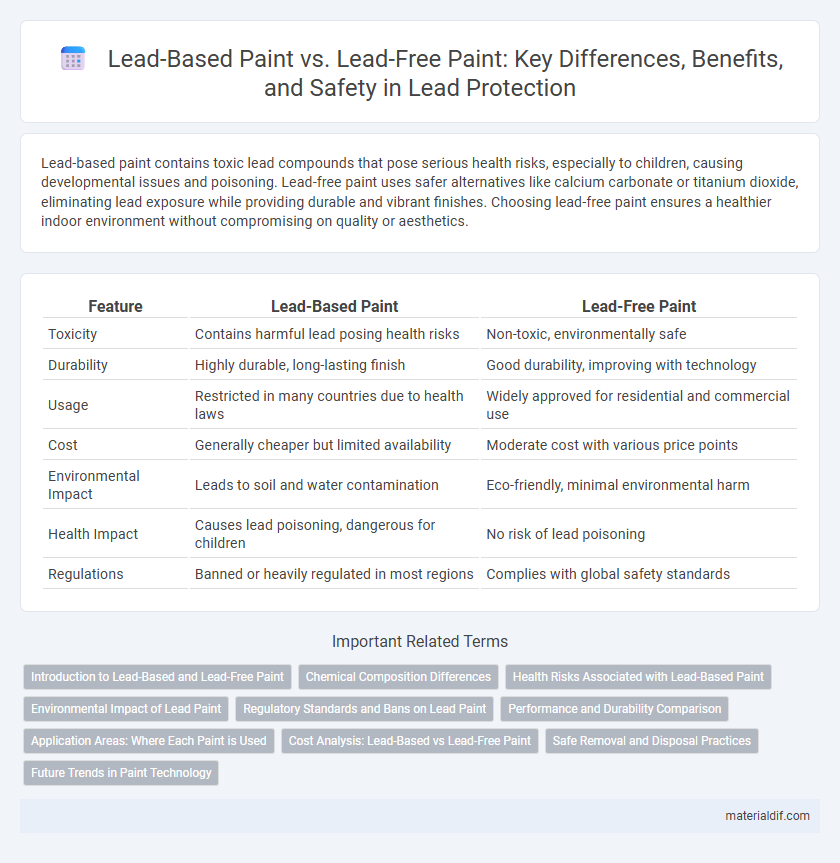Lead-based paint contains toxic lead compounds that pose serious health risks, especially to children, causing developmental issues and poisoning. Lead-free paint uses safer alternatives like calcium carbonate or titanium dioxide, eliminating lead exposure while providing durable and vibrant finishes. Choosing lead-free paint ensures a healthier indoor environment without compromising on quality or aesthetics.
Table of Comparison
| Feature | Lead-Based Paint | Lead-Free Paint |
|---|---|---|
| Toxicity | Contains harmful lead posing health risks | Non-toxic, environmentally safe |
| Durability | Highly durable, long-lasting finish | Good durability, improving with technology |
| Usage | Restricted in many countries due to health laws | Widely approved for residential and commercial use |
| Cost | Generally cheaper but limited availability | Moderate cost with various price points |
| Environmental Impact | Leads to soil and water contamination | Eco-friendly, minimal environmental harm |
| Health Impact | Causes lead poisoning, dangerous for children | No risk of lead poisoning |
| Regulations | Banned or heavily regulated in most regions | Complies with global safety standards |
Introduction to Lead-Based and Lead-Free Paint
Lead-based paint contains lead compounds that provide durability and moisture resistance but pose significant health risks, especially to children and pregnant women. Lead-free paint is formulated with alternative, non-toxic ingredients that eliminate the dangers of lead exposure while maintaining effective coverage and longevity. Regulatory measures have increasingly mandated the use of lead-free paint to ensure safer indoor and outdoor environments.
Chemical Composition Differences
Lead-based paint contains lead compounds such as lead carbonate and lead chromate, which provide durability and vibrant colors but pose significant health risks due to toxicity. Lead-free paint substitutes these with safer pigments and binders, utilizing titanium dioxide, zinc oxide, and organic compounds to achieve similar aesthetic qualities without harmful heavy metals. The chemical composition shift minimizes environmental contamination and lead poisoning hazards, making lead-free paint a safer alternative for residential and commercial use.
Health Risks Associated with Lead-Based Paint
Lead-based paint contains high levels of toxic lead, posing significant health risks such as neurological damage, developmental delays in children, and respiratory issues in adults. Exposure occurs through peeling, chipping, or surface dust, making deteriorating lead paint a critical hazard in older buildings. In contrast, lead-free paint eliminates these risks by using safer, non-toxic ingredients, providing a healthier environment for occupants.
Environmental Impact of Lead Paint
Lead-based paint contains toxic lead compounds that pose significant environmental hazards, contaminating soil and water through flaking and chipping over time. Lead-free paint eliminates these risks by using safer, non-toxic alternatives that reduce soil and water pollution. The environmental impact of lead-based paint is profound, contributing to ecosystem degradation and long-term health issues in wildlife and humans.
Regulatory Standards and Bans on Lead Paint
Regulatory standards for lead-based paint vary globally, with many countries, including the United States and European Union members, enforcing strict bans on lead content exceeding 90 parts per million (ppm) to protect public health. The U.S. Consumer Product Safety Commission (CPSC) banned residential lead-based paint in 1978, and similarly, the EU's Restriction of Hazardous Substances (RoHS) Directive limits lead use in consumer products. Lead-free paint complies with these regulations, offering safer alternatives for indoor and outdoor applications by eliminating the toxic risks associated with lead exposure, especially in children.
Performance and Durability Comparison
Lead-based paint offers exceptional durability and superior resistance to moisture, making it well-suited for high-traffic or exterior areas. Lead-free paint formulations have significantly improved, now providing comparable performance with enhanced environmental safety and reduced health risks. Advances in acrylic and latex technologies have bolstered the longevity and adhesion of lead-free paints, narrowing the performance gap with traditional lead-based options.
Application Areas: Where Each Paint is Used
Lead-based paint is commonly applied in industrial settings, metal surfaces, and historical buildings due to its durability and corrosion resistance, despite health hazards. Lead-free paint is preferred in residential interiors, schools, and hospitals, prioritizing safety and environmental standards while offering similar protective qualities. Application areas for lead-based paint are generally restricted by regulations, whereas lead-free paint enjoys broader acceptance for everyday use and modern construction projects.
Cost Analysis: Lead-Based vs Lead-Free Paint
Lead-based paint typically incurs lower upfront costs compared to lead-free paint due to cheaper raw materials and widespread availability; however, long-term expenses associated with health risks, remediation, and regulatory compliance significantly increase overall costs. Lead-free paint involves higher initial investment attributed to safer, non-toxic components and advanced manufacturing processes but reduces liabilities and maintenance expenditures over time. Evaluating total cost of ownership highlights lead-free paint as a more cost-effective and sustainable solution despite its premium price tag.
Safe Removal and Disposal Practices
Safe removal of lead-based paint requires specialized training and certified professionals to prevent lead dust contamination. Lead-free paint eliminates health hazards during renovation, reducing the need for costly containment measures. Proper disposal of lead-based paint debris must follow EPA regulations to avoid environmental contamination.
Future Trends in Paint Technology
Emerging innovations in paint technology prioritize eco-friendly and non-toxic formulations, with increased research on lead-free alternatives that match the durability and aesthetic qualities of traditional lead-based paint. Advancements in nanotechnology and bio-based compounds are driving the development of sustainable paints that reduce environmental impact and health risks associated with lead exposure. Market trends indicate a regulatory push toward mandatory lead-free standards, fostering widespread adoption of safer coatings in residential and industrial applications.
Lead-Based Paint vs Lead-Free Paint Infographic

 materialdif.com
materialdif.com